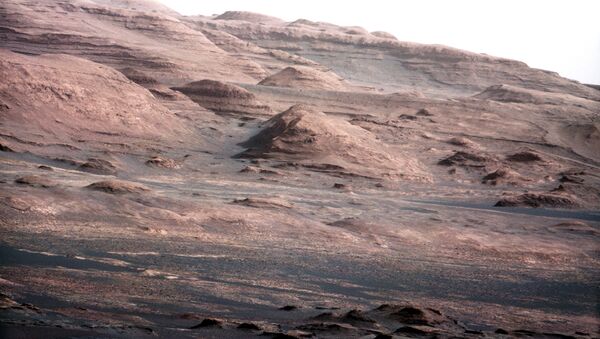MOSCOW, December 9 (Sputnik) – NASA's Curiosity Rover has found clues of an ancient lake on Mars, shedding light on how water shaped this Martian landscape, new research explains, reports Nature World News.
"If our hypothesis for Mount Sharp holds up, it challenges the notion that warm and wet conditions were transient, local, or only underground on Mars," Ashwin Vasavada, Curiosity deputy project scientist at NASA's Jet Propulsion Laboratory (JPL), said in a statement.
"A more radical explanation is that Mars' ancient, thicker atmosphere raised temperatures above freezing globally," he added, "but so far we don't know how the atmosphere did that.
NASA's Curiosity rover is working together with scientists to understand the reason of the protruding mountain in a barren crater on Mars, reports Associated Press.
Layers of Intrigue: Data show millions of years of lake sediment built Mars' Mt Sharp http://t.co/V1zd1bTiRx pic.twitter.com/i5I5yB2pc7
— Curiosity Rover (@MarsCuriosity) 8 декабря 2014
Scientists said that the rock images indicated that the 3-mile-high Mount Sharp may had formed in a big lake bed over a million or even tens of millions of years. According to scientists the deposits of sediment seem to have shaped the mountain.
"The great thing about a lake that occurs repeatedly, over and over, is that each time it comes back it is another experiment to tell you how the environment works," Grotzinger said. "As Curiosity climbs higher on Mount Sharp, we will have a series of experiments to show patterns in how the atmosphere and the water and the sediments interact. We may see how the chemistry changed in the lakes over time."
Layers of intrigue: @MarsCuriosity find clues to how a Martian mountain inside of a crater came to be. Watch: http://t.co/czFsGY7SZa
— NASA (@NASA) 9 декабря 2014
That raises the question of whether microbial life may have existed there in those wet ancient times.
"This lake was large enough, it could have lasted millions of years — sufficient time for life to get started and thrive, sufficient time for lake sediment to build up to form Mount Sharp," said Michael Meyer, lead scientist of NASA's Mars exploration program.
According to AP, the rover’s latest images could mean Mars' warm, wet period occurred about 3.5 billion years ago, more recent than it had been assumed before. Martian lakes could have lasted longer than previously alleged. Scientists are unsure whether this wet period was continuous or interrupted by dry spells.
Meyer acknowledged that even here on Earth, "we don't have a very good handle" on how long it takes life to originate and how long a favorable environment needs to last before for optimum condition for life to thrive. Due to that understanding, the possibility of whether life once existed on other planets is much more complicated.
Curiosity has been exploring Gale Crater since its arrival on Mars two years ago; the rover reached the base of Mount Sharp a few months ago. The crater, 96 miles across, was caused by an asteroid impact, as reported AP.


